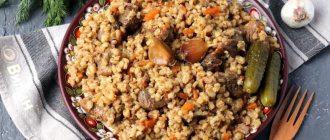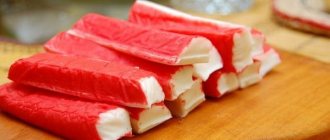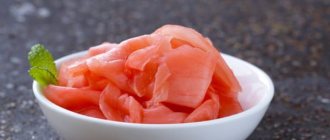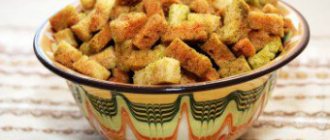Rice of the right varieties
Experienced chefs will immediately tell you what the main secret of pilaf is. This is the right rice. The main requirement is that the grains must be quite dense and hard, with a minimum starch content. Only then will they not boil over during simmering and retain their perfect crumbliness. Experienced craftsmen advise giving preference to Uzbek and Tajik varieties, such as devzira, alanga, oshpar, barakat, akmarzhan. Any brown rice varieties that retain the bran shell are also allowed. But you shouldn’t replace them with steamed varieties. Instead of crumbly rice, you will get viscous rice porridge with meat. Before cooking, rice should be rinsed in water 6-8 times. This will help get rid of starch dust and prevent the grains from sticking together in the cauldron. Some housewives soak the washed grains in cold water for half an hour.
Variations on the theme “Pilaf” - a selection of recipes
Homemade pilaf with chicken and garlic - dietary
The principle of preparing this dish is no different from the traditional version. The only difference is the type of meat.
Pilaf with chicken
Divide the chicken into portions. We prepare zirvak in the usual way. We peel two or three large heads of garlic from the roots (do not touch the husks!!!), and lower them into boiling zirvak 10 minutes before adding rice.
Remove the finished chicken and separate the meat from the bones. We send the meat back to the cauldron and add rice. Before serving, remove the garlic, peel it and place it on top of the finished dish.
Pilaf with quince, pumpkin or persimmon
For pilaf, only the hard pulp of quince, persimmon or pumpkin is used. Cut into large pieces and put into zirvak immediately before adding rice.
Next, prepare the pilaf in the usual way. When serving, pilaf is placed in a portioned plate, with quince, persimmon or pumpkin placed on top.
Wedding pilaf with dried fruits and peas nokhat
To prepare this pilaf, raisins (red, white and black) and dried apricots are used. Nohat peas (ordinary ones will not work) are prepared in advance. It is best to soak it in cold water overnight.
If this is not possible, then you should cook it for at least an hour in unsalted water. To make the nokhat cook even faster, you can add a pinch of tea soda.
The prepared peas are placed in the cauldron immediately after water has been poured into the frying pan. It should be cooked in a zirvak for at least an hour. After which you can add washed dried fruits and rice.
It is served this way: put the pilaf on a dish, put finely chopped meat and boiled quail eggs on top. The edges of the dish are decorated with circles of horse sausage (kazy).
Pilaf with dolma (stuffed cabbage rolls made from grape leaves)
The process of preparing this dish is somewhat labor-intensive, but the result lives up to all expectations.
We divide the meat into two parts. We will fry one of them and turn the other into minced meat. We prepare zirvak in the usual way. While the cauldron is boiling, let's make cabbage rolls.
Fresh grape leaves should be slightly dried in the sun and poured boiling water for a couple of minutes. Salt and pepper the minced meat and form small cabbage rolls.
Then we string them on a long strong thread to make dolma “beads”. We lower these “beads” into the zirvak, placing the ends of the threads so that they slightly hang over the edges of the cauldron.
Stuffed cabbage rolls are cooked for about 15 minutes, no more. Carefully add the rice and continue the process of preparing pilaf in the usual way.
When ready, carefully rake the rice and pull out our “beads” using the free ends of the threads. Carefully remove the cabbage rolls from the strings and place them on top of the pilaf. You can also serve them separately, topped with kefir and garlic or lemon juice.
Dietary pilaf Avicenna
In some regions, pilaf is prepared in an unusual way. Cooking dietary pilaf Avicenna requires certain skills. The reverse principle works here.
Place meat and onions, pre-fried in a small amount of oil, on the bottom of a clean, cold cauldron, then carrots. Then carefully lay out the soaked rice and pour in water. Place on high heat and cook until all the water has boiled away.
Then pour hot oil and close the lid. And this pilaf is served in the reverse order - first rice, then carrots, then meat and onions.
Pilaf with fish
For pilaf, fish with thick flesh and no bones is taken (pike perch, salmon). Pieces of fish are fried directly in a cauldron, then taken out and traditional pilaf is prepared in this oil. Serve in shallow plates - lay out pilaf, and next to it a piece of fried fish.
Pilaf with seafood
An exotic version of pilaf is prepared in a completely different way. First fry the chopped onion in a small amount of oil, then the rice. Then spices are put there (you can take a set for fish dishes) and barberry.
Then add carrots cut into strips and fill with water. Without stirring, carefully distribute the seafood on top and cover with a lid.
The dish should simmer for at least an hour. Serve garnished with chopped parsley. This version of pilaf can also be prepared with mushrooms.
Sweet pilaf in pumpkin
Wash a medium-sized pumpkin, cut off the top, remove the seeds and place in a preheated oven for half an hour. Separately, boil the rice until half cooked and mix with raisins and nuts.
Add finely chopped apple, sprinkle with sugar and cinnamon. Then fill the pumpkin with rice filling, cover with the cut off top and bake in the oven for 40 minutes.
Perfect meat
The next important ingredient for pilaf is meat. In classic Central Asian pilaf it is lamb and only lamb. Moreover, it should be the meat of an adult animal, preferably shoulder, brisket or back. Only it gives the pilaf a unique juiciness and intense taste. In Muslim countries, for obvious reasons, pork is not used. But in Asian countries this option is quite acceptable. Beef, chicken, turkey and even fish are also added to pilaf. It is better not to take veal. From long simmering it becomes tough and does not give a rich aroma and taste. In any case, the meat should be fresh or chilled, but in no case frozen. Cut it into cubes no smaller than 5 × 5 cm. In some recipes, the meat is fried in large pieces and chopped before serving.
Useful tips and tricks
To ensure that the dish turns out perfectly from the first cooking, you can follow several useful tips:
- Rice. It is best to give preference to the traditional variety of rice (“devzira”), from which pilaf is prepared in Uzbekistan. Cooking from other varieties (Chungara, Lazar) is acceptable, but the classic recipe requires this type of rice.
- Meat. Old meat will be too tough and lamb will be too tender. It is also not recommended to choose pieces with yellow and loose fat. If you don’t like the smell of lamb, you can choose sheep meat; it has an identical taste, but without a characteristic smell.
- Meat alternative. It is acceptable to replace lamb with beef, pork, chicken and even fish, but then the dish cannot be called “Uzbek pilaf”.
- Preparation of products. Traditional pilaf is cooked in a mixture of fat and vegetable oil used for frying onions. Carrots should not be grated, otherwise they will quickly boil. Do not chop the onion too finely so that it does not burn. Seasonings may vary, but the use of cumin, barberry and coriander is mandatory. Rice quickly absorbs salt, so you can add more.
- Dishes. A cauldron is chosen for cooking because this thick-walled cookware is capable of frying ingredients to the required degree and does not allow moisture to escape from under the lid. Unlike modern frying pans or saucepans.
Vegetable set
The two main vegetables in pilaf are onions and carrots. Almost all recipes use onions. Sometimes you can find red onions, which give a more expressive piquant taste. The onion is cut into fairly large half rings. If you chop it too much, the onion will quickly overcook. In Central Asian countries, yellow carrots are added to pilaf. However, the more common orange varieties will not affect the taste much. The root vegetable is cut into thick, long strips. It’s not worth chopping carrots, even on the coarsest grater. In this form, it will quickly burn, and this will definitely ruin the taste of the pilaf. What else can you add to pilaf? Raisins, dried apricots, dates and other dried fruits are used in Azerbaijani pilaf. They are first steamed in boiling water, dried and placed whole in pilaf.
How to cook with chicken
The rice treat with poultry is tender, aromatic and looks very appetizing.
A simple and original dish will appeal to all lovers of good cuisine and is ideal for a children's table.
Required components:
- chicken – 0.75 kg;
- carrots – 350 g;
- rice – 0.4 kg;
- large onion - 1 pc.;
- garlic – 1 pc.;
- hot pepper, Italian herbs, cumin, thyme, salt, turmeric - 5 g each.
Cooking:
- Place the washed rice in warm water and leave for forty minutes.
- Peel the plant products, then cut the onion into halves of rings, chop the carrots on a coarse grater, and divide the garlic into slices.
- Wash the bird, dry with a napkin, chop into medium pieces.
- Pour vegetable fat into a frying pan, place chicken meat in it and fry until brown.
- Then add the onion, and when it is browned, add the chopped carrots and cook for another four minutes.
- Salt the fried mass, season with seasonings, add water (550 ml) and add cloves of garlic.
- Bring the contents of the dish to a boil, cover with a lid and simmer over low heat for thirty minutes.
- Add rice to the boiling liquid, add a little water (so that its level is just above the grains) and simmer the pilaf in a frying pan for twenty-five minutes.
Before serving, remove the garlic, then transfer the treat to a large plate, garnish with parsley sprigs and place on the table.
Oil and a bouquet of spices
From time immemorial in Central Asia, pilaf was cooked in fat tail fat. Modern recipes increasingly feature cottonseed or sesame oil. At home, you can be content with refined sunflower oil. Another important point is what spices are added to the pilaf. The classic set includes cumin grains, dried barberries, freshly ground black or red pepper. Several small hot peppers are buried in the swollen grains of rice. Garlic is placed in cloves or whole heads directly with the husk. What can I replace this set with? In the Caucasus, pilaf is seasoned with suneli hops, in India - with saffron, in Mediterranean countries - with thyme and coriander. By and large, there are no strict canons regarding seasonings for pilaf. You can safely improvise, choosing combinations that interest you.
How to choose products - main rules
To prepare pilaf at home from beef, lamb or poultry, you need to pay special attention to the right choice of products. Not only the appearance, but also the taste of the finished dish depends on the quality of meat, rice or oil.
Oil
Traditionally, pilaf is prepared using unrefined cottonseed oil. Before cooking, it is heated until it smokes and a small onion is put in, which will absorb all the unpleasant odors.
In some regions of Uzbekistan, black cumin oil is used for pilaf - it gives the finished dish a brown color and a rich aroma.
You can use refined sunflower or olive oil - it will not spoil the taste.
You cannot cook pilaf with ghee and corn oil. Not only does it foam a lot when frying, but it can also ruin the rice.
Meat
Real pilaf is made from lamb. But you can take absolutely any one you like. Delicious pilaf is made from beef or poultry.
Poor families replace meat with boiled chicken or quail eggs - the dish is no less nutritious. Exotic lovers can try cooking pilaf with fish, seafood and mushrooms.
Do not use frozen meat. It should only be fresh.
Carrot
The most delicious pilaf is made from yellow carrots. Red gives the dish a slightly sweet taste. Gourmets love to use both varieties of this root vegetable in cooking.
The main condition is that the carrots must be fresh and juicy.
You cannot prepare pilaf from frozen semi-finished products or old, “wooden” carrots.
Onion
Any type of onion - white, red, yellow or brown - is absolutely suitable for preparing pilaf. You cannot use green, shallots or leeks - these varieties will be useful when decorating salads that you serve with pilaf.
Rice
The ideal pilaf is prepared from Laser rice. Its grains are long, transparent and contain almost no starch, so the pilaf turns out crumbly.
A dish made from round rice (kenzo, alanga) will be no less tasty. These varieties are loved because during the cooking process they greatly (almost triple) increase in volume. Therefore, for a large family this is the best option.
The Devzira variety in the East is used exclusively for preparing pilaf at home. It differs from regular rice in its dark brown color.
But be careful when buying - cunning oriental sellers have long learned to counterfeit it, mixing white rice with different dyes (even crushed brick).
To avoid getting into trouble, try to wet a few beans before purchasing. Real devzira will not stain your hands or change color.
You cannot use crushed rice or chopped rice. Otherwise, instead of pilaf, no matter how hard you try, you will end up with a viscous porridge with meat.
Spices
Cumin (cumin) seeds give this dish a unique taste. The main set of spices is cumin, barberry grains and salt. In ready-made sets, sellers can add sultanas (white or black) and saffron (turmeric) to add rich color.
You cannot add spices with a strong aroma (ginger, cilantro, star anise, cumin). Otherwise, you won’t feel the taste of the pilaf itself.
Exact proportions
The proportions of ingredients play an important role in preparing pilaf. It's pretty easy to remember them. Rice, meat and carrots are taken in approximately equal proportions. Onions for such a quantity of products require at least 2-3 heads. You shouldn't skimp on oil either. For 1 kg of rice you need at least 250 ml of vegetable oil. The amount of water or broth depends on the container you are cooking in. The liquid should cover the ingredients by 1-2 cm. To be on the safe side, first pour in a little water and wait until it is absorbed. It is better to add a little more than to evaporate excess moisture for a long time. Spices are introduced based on personal taste preferences. If you don’t mind adding some sparkle to your pilaf, add more garlic, hot pepper and hot seasonings.
Features and rules for preparing pilaf
Pilaf (a classic Uzbek recipe involves the use of rice, meat and vegetables) recipe may differ depending on the type of meat. Always use a large amount of fat, which must be calcined first. Rice and vegetables are cooked in one bowl.
In the cauldron
Before cooking, the meat and rice are washed, and the top layer of peel is removed from the onion and divided in half.
The remaining vegetables are peeled and finely chopped:
- Fry the onion in oil until it takes on a golden hue.
- Add meat and cook until crust appears. Then it is temporarily put away in another container.
- The vegetables are cooked for a few more minutes, then the meat is added back. Sprinkle with spices and add rice. Pour in 1 liter of water. Place garlic in the center.
- Cover with a lid and cook until all the liquid has evaporated.
Pilaf. Classic Uzbek recipe - Let it sit for a while before serving.
In a frying pan
If you don’t have a cauldron, you can use a frying pan, but keep in mind that the thickness of the walls of the pan is different:
- Vegetables are fried in oil until golden brown, then meat and spices are added.
- When the ingredients are ready, add rice, add water and place garlic on top.
- Reduce the heat, cover the pan with a lid and cook for half an hour, stirring the ingredients regularly.
- When all the liquid has evaporated, let the dish sit for a few minutes.
In a saucepan
Pilaf is prepared at home in a pan, choosing a model that has a thick bottom and a non-stick coating:
- The meat is fried in oil until the juice is released and then vegetables and spices are added. Cover with a lid and cook until all ingredients are softened.
- Add rice, add salt, pepper and garlic. Add water again and cook until the liquid evaporates, stirring regularly.
- The finished dish is infused under the lid for half an hour.
It's all in the cauldron
The choice of utensils for pilaf should also be approached carefully. Experts experienced in this matter firmly stand on their own - real pilaf can only be cooked in a cauldron. It is best if it is cast iron or copper, in extreme cases - aluminum. An acceptable alternative to a cauldron can only be a duckling. Thanks to the thick walls and heavy bottom, the rice simmers at the right temperature without burning or sticking together. For all their advantages, deep frying pans with a non-stick coating or woks do not allow you to fully reveal the full bouquet of aromas and tastes of pilaf. The same can be said about the slow cooker.
With added vegetables
Proponents of proper nutrition will certainly enjoy the crumbly, healthy pilaf with the addition of peas, sweet peppers and tomatoes. For the dish, you should choose high-quality products; ripe, strong vegetables, lean pork and round rice are suitable.
Required components:
- onion – 1 pc.;
- canned peas - jar;
- rice – 250 g;
- carrot – 1 pc.;
- pork pulp – 0.4 kg;
- bell pepper – 1 pc.;
- spices, spices, salt - to your taste;
- tomatoes – 2 pcs.
Cooking:
- Wash the rice thoroughly, then put it in water and soak for forty-five minutes.
- Cut the peeled onion into squares, chop the carrots into small cubes.
- Remove seeds from sweet peppers, wash, then cut into strips.
- Pour boiling water over the tomatoes, peel them, and turn them into small squares.
- Uncork the jar of peas and pour out all the liquid.
- Rinse the pork and divide it into rectangular pieces.
- Heat a saucepan with vegetable oil, put meat in it and fry until golden brown. Then add the carrots and onions and, stirring, simmer for eight minutes.
- Place the chopped peppers in a saucepan and fry with the rest of the ingredients for five minutes. After this, add the tomatoes, add the peas, cover with a lid and cook for another three minutes.
- Combine the fried meat with rice, pour in water (it should cover the cereal by 2 cm), season with spices, add salt and simmer over low heat until all the liquid has evaporated.
Gently mix the prepared treat, distribute among serving plates and serve to everyone present.
Classic pilaf with lamb
Now that we have found out what is needed for pilaf, we suggest preparing this dish according to the classic Uzbek recipe. Choose moderately fatty lamb, taking into account the fact that here we will use fat tail.
Ingredients:
- lamb pulp - 1 kg
- fat tail fat - 300 g
- carrots - 1 kg
- Devzira rice – 1 kg
- onions - 2 large heads
- garlic - 3 heads
- hot red pepper - 2 pods
- coarse salt - 1 tbsp. l.
- cumin grains - 1 tsp.
- barberry berries - 1 tsp.
- additional spices - optional
Cut the fat tail fat into pieces approximately 1.5 × 1.5 cm. Cut the lamb coarsely into 5 × 5 cm cubes. Cut the onion into thick half rings. First cut the carrots into thick slices and then into long strips.
Heat a 5-6 liter cast iron cauldron over medium heat. We put in the tail fat, melt it, and catch the greaves with a slotted spoon. Increase the flame to maximum and add the prepared meat. Fry it quickly, stirring with a wooden spatula. It is necessary that the pieces are covered with a thin crust on all sides, but not dry out.
Reduce heat to medium, add onion, fry with meat until translucent, stirring occasionally. Now add the carrots, distribute them evenly and fry until they become soft. Add hot water until it slightly covers the carrots.
Mash the cumin grains a little with a pestle for a brighter aroma. Add cumin, barberries, whole hot peppers, heads of garlic and salt to the cauldron. Mix everything carefully - we have a zirvak. Place the pre-washed rice in an even layer on top of the zirvak and immediately fill one or two fingers with water. When the liquid boils, reduce the flame to a minimum, cover the cauldron with a lid and simmer for half an hour. Then, very carefully, using a wooden spatula, move the rice from the walls to the center. Otherwise, the lower layers will be overcooked and the upper layers will dry out. At the same time, we do not disturb Zirvak. Cover the cauldron with a lid and simmer for about another half hour. If the rice is completely cooked, but there is still liquid at the bottom, use a wooden stick to make several deep holes all the way to the bottom. Let the finished pilaf brew in a cauldron without fire for another 15–20 minutes.
Pork pilaf
Another popular version of pilaf is pilaf made from pork or pork ribs. The dish turns out aromatic and very tasty. If you cook pilaf correctly, the meat will be tender, the rice will be crumbly, soaked in meat and vegetable juices, as well as aromatic seasonings. This hearty pork dish can be a tasty and nutritious meal for your family. In taste, it is not inferior to real Uzbek lamb pilaf.
Ingredients for making pork pilaf
| Pork | 500 g |
| Rice | 2 tbsp. |
| Bulb onions | 2 pcs |
| Carrot | 2 pcs |
| Vegetable oil | 50 ml |
| Seasoning for pilaf | taste |
| Salt | taste |
| Garlic | 1 head |
Step-by-step preparation of pork pilaf with photos
- Heat the vegetable oil thoroughly in a saucepan or cauldron. Dip chopped pork, pulp or ribs into it.
- Fry the meat over high heat on all sides until golden brown, about 10 minutes.
- Add chopped onions and carrots to the fried meat.
- Simmer everything together for about 10-12 minutes, stirring occasionally.
- Towards the end of the stew, add seasonings for the pilaf; they should include cumin, ground coriander, paprika, and turmeric. Salt and pepper the zirvak, the resulting mixture of meat and vegetables.
- Add washed rice to the cauldron with zirvak, stick a head of garlic into it. Pour boiling water over the rice, about 4 cups. The water should cover the rice by 2 cm.
- Bring the pilaf to a boil, and then reduce the heat to low.
- Cover the saucepan with a lid and simmer the pilaf until fully cooked, about 40 minutes.
- After turning off the heat, let the pilaf brew for another 10-15 minutes.
- Serve pork pilaf with fresh vegetable salad and herbs. Bon appetit!











